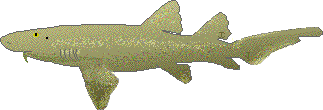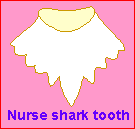Advertisement.
EnchantedLearning.com is a user-supported site.
As a bonus, site members have access to a banner-ad-free version of the site, with print-friendly pages.
Click here to learn more.
(Already a member? Click here.)
 |
ALL ABOUT SHARKS! |
 |
 |
NURSE SHARK
Ginglymostoma cirratum |
GENERAL DESCRIPTION
The nurse shark is a large, sluggish, bottom-dwelling shark that is generally harmless unless provoked. It has very strong jaws, a stout body, and a wide head with obvious barbels (thin, fleshy, whisker-like organs on the lower jaw in front of the nostrils that sense touch and taste). The fourth and fifth gill slits are very close together. The dorsal fins (on the shark's back) are almost the same size and are rounded. Behind each eye there is a spiracle, an organ that takes in water used for breathing when the shark rests at the bottom.
The skin is dark gray-brown on top and some nurse sharks, especially the young, have spots. The nurse shark is smoother to the touch than most other sharks.
They are nocturnal hunters that rest during the day in groups. Nurse sharks do well in captivity.
No one is sure how they got their name; it might be because they make a sucking sound that is a little like the sound of a nursing baby.
SIZE
Nurse sharks range in size from about 2-13 feet (0.75-4 m) long. The largest are about 14 feet (4.25 m) long and weigh up to 730 pounds (330 kg).
TEETH
 The nurse shark has thousands of replaceable teeth which are serrated and fan shaped; they are capable of crushing shellfish. The teeth are arranged in rows that rotate into position when one is needed (when older ones are broken or lost).
The nurse shark has thousands of replaceable teeth which are serrated and fan shaped; they are capable of crushing shellfish. The teeth are arranged in rows that rotate into position when one is needed (when older ones are broken or lost).
DIET AND FEEDING HABITS
Nurse sharks eat bottom-dwelling fish, shrimp, squid, octopus, crabs, sea snails, lobster, sea urchins, and coral. The barbels (thin, fleshy, whisker-like organs on the lower jaw in front of the nostrils that sense touch and taste) help the shark locate potential food. Most hunting is done at night.
NURSE SHARK ATTACKS
The nurse shark is a large, sluggish, docile shark that is generally harmless unless provoked.
SOCIAL GROUPS
Nurse sharks congregate in schools. They are sluggish or rest during the day, sometimes piled together on the bottom.
HABITAT
Nurse sharks live in warm waters and are shallow-water sharks (going from the surface to 230 feet = 70 m deep). They are bottom-dwellers, living near sandy beaches, mudflats, and sandbars. They are common in coral reefs.
DISTRIBUTION
Nurse sharks are found in the western Atlantic Ocean and the eastern Pacific Ocean.
REPRODUCTION
Nurse reproduce via aplacental viviparity. In aplacental viviparity, the eggs develop inside the body after internal fertilization and hatch within the body of the mother. Litters consist of 20-30 pups that are tiny replicas of the adult.
Nurse sharks reach maturity at about 15 to 20 years old.
MIGRATION
Nurse sharks do not migrate as the water becomes cooler; their activity level simply decreases.
NURSE SHARK CLASSIFICATION
Kingdom Animalia (animals)
Phylum Chordata
SubPhylum Vertebrata (vertebrates)
Class Chondrichthyes (cartilaginous fish)
Subclass Elasmobranchii (sharks and rays)
Order Orectolobiformes
Family Orectolobidae
Genus Ginglymostoma
Species cirratum |
 |
NURSE SHARK ACTIVITIES
A print-out about nurse sharks.
A first grade addition activity. Solve the 1-digit addition problems, then do letter substitutions to answer a shark question.
| Information Sheets About Sharks (and Rays) |
Just click on an animal's name to go to that information sheet. If the shark (or ray) you're interested in isn't here, check the Shark Dictionary.
Enchanted Learning®
Over 35,000 Web Pages
Sample Pages for Prospective Subscribers, or click below
Click to read our Privacy Policy
Enchanted Learning Search
|
Search the Enchanted Learning website for:
|
Advertisement.
Advertisement.
Copyright ©1999-2018
EnchantedLearning.com ------ How to cite a web page

